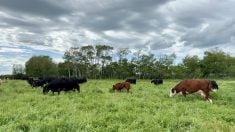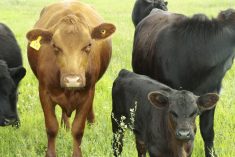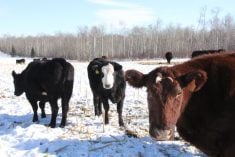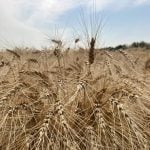In my last column, I addressed the use of low-quality roughages in wintering rations. That column was prompted by widespread drought across Western and Central Canada. Recent rains have helped alleviate dry conditions; however, they have not mitigated impending feed shortages. As a result, producers continue to scramble for winter feed, with many looking to byproduct feeds to fill the shortfall. With this column, I want to look at some of the common byproduct feeds on the market.
Read Also

Canadian Beef Check-Off Agency reports on investments and activities
The check-off agency’s work behind the scenes is what ensures cattle check-off dollars are invested wisely, accounted for transparently and deliver measurable value back to producers and importers.
However, before getting into specifics, I think it is important to address some of the challenges encountered with byproduct feeding programs. First, many of these alternatives are byproducts of the cereal/oilseed processing sectors. As a result, nutritional value will reflect the original grain/oilseed source and the nature of the industrial processing applied to that grain/oilseed source. Knowledge of nutrient content, ideally through a feed test, is critical for efficient use.
Second, the availability of a given byproduct varies throughout the year. In drought situations, demand and price always peak. Thus if one wants to ensure a consistent supply at a competitive price, one needs to act early when dealing with brokers or suppliers.
A third factor to consider is storage. Byproducts will vary in density as well as in moisture and fat content. In addition to adequate storage capacity, one needs to consider potential issues with bridging (i.e. high-fat byproducts) in bins, and shrinkage (i.e. oat hulls) if stored on the ground.
Finally, certain byproducts can contain potential antinutrients such as sulphur in canola or mycotoxins in dried distillers grains with solubles (DDGs). Knowledge of feeding situations where potential toxicity issues can arise is critical.
Bearing in mind these challenges, let’s examine the more common byproducts available across the country. Note that all nutrients are expressed on a dry matter basis. Take, for example, byproducts of the oilseed (i.e. canola and soybean meal) and ethanol (i.e. DDGs) sectors. Oilseed processing can involve heating and solvent extraction or cold pressing (i.e. extrusion) of the seed, while ethanol production involves yeast-based fermentation of the starch content of cereal grains. Byproducts of both sectors are excellent sources of crude protein (CP) and intermediate to excellent sources of energy. For example, solvent-extracted canola meal is typically 38 to 40 per cent crude protein and has a net energy of gain value (NEg) of 1.0 to 1.1 Mcal/kilogram (kg).
To put this energy value in perspective, consider that oat grain has a NEg value that ranges from 1.1 to 1.2 Mcal/kg while barley grain has a NEg value of 1.3 to 1.4 Mcal/kg. Cold-pressed canola meal with a higher residual fat content can have a NEg value of 1.47 Mcal/kg or higher. Both regular and cold-pressed canola meal are excellent protein feeds for beef cattle.
Solvent-extracted soybean meal has a CP content of 49 to 53 per cent and a NEg value that equals or exceeds that of many cereal grains. While also an excellent protein source for beef cattle, its high digestibility and resulting price typically dictates use in monogastric rather than beef cattle rations.
Corn DDGs are typically lower and more variable (i.e. 27 to 32 per cent CP) in protein than wheat DDGs (i.e. 38 to 40 per cent CP). However, corn DDGs are higher in energy (i.e. 1.45 to 1.55 Mcal NEg/kg) than wheat DDGs (i.e. 1.35 Mcal NEg/kg). Nutrient variability in corn DDGS reflect variation between ethanol plants in fat extraction. High residual fat typically translates to higher energy but lower protein content. Both products are widely used in the finishing sector as protein and energy sources.
Milling/value-added processing of cereal grains and pulses can also result in byproducts that find a home in cattle rations. Examples include wheat midds, brewers’ grains, corn/wheat cracks and specialty pellets. For example, wheat midds — also referred to as millrun — are a byproduct of the grain milling industry. While composition depends on the source, they typically consist of wheat screenings, bran, germ and rejected flour. They are a good source of protein (i.e. 14 to 18 per cent CP) and an intermediate source of energy (i.e. 1.13 to 1.29 Mcal NEg/kg).
Dried brewers’ grains are a byproduct of the malt industry. They consist of dried sprouts and hulls removed from germinated malt barley. Like wheat midds, dried brewers’ grains are a good source of protein (i.e. 18 to 24 per cent CP) and an intermediate source of energy. Both byproducts work well as energy/protein supplements in wintering cow and backgrounding calf rations.
Specialty pellets are a class of manufactured feed pellets that comprise a blend of extruded flax and/or canola seed, pulses, alfalfa and possibly other high-protein ingredients. The highly digestible and specialized nature of the protein and fat of such pellets typically results in the dairy sector being the target market, although they do fit in niche markets such as that of grass-fed beef.
Wheat or corn cracks are cleaning products consisting of cracked grain, grain dust, shrunken kernels, cereal and oilseed screenings. While variable, both products are relatively good sources of energy, in some cases approaching that of the parent grain.
In closing, if one is looking to stretch limited feed resources, byproduct feeds may be part of the solution. However, they come with challenges and an equally important part of the solution is seeking the advice of a qualified nutritionist.

















